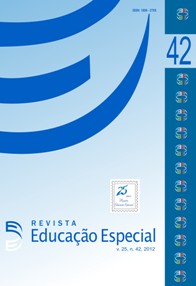Brazilian sign language and cochlear implant: case report
DOI:
https://doi.org/10.5902/1984686X2318Keywords:
Deafness, Cochlear implant, Brazilian Sign Language.Abstract
The auditory loss is one of the more common sensorial privations in the men. The main consequence of the auditory loss inhabits consequent in its repercussion on the development of the verbal language and intervening with all the process of learning of the reading and writing. The cochlear implant is an electronic device, partially implanted, that it aims at to provide to its users next auditory sensation the physiological one. Deep interim is a good option to the carriers of neurossensorial deafness, it does not assure the development of the auditory abilities and verbal language. Thus, for not developing the verbal language, the individuals with cochlear implant cannot be private of the possibility of the acquisition and the development of the language; therefore they can make this using one another form of communication - the language of signals. The objective of this story is to describe the experience of the attendance to multidiscipline of a using child of cochlear implant. B.V.S.R eight years, masculine, carrying sort of bilateral deep neurossensorial loss auditory since the neonatal period. It carried through surgery of cochlear implant to the three years of age being folloied according to aurioral boarding. Had to presented overhead, case with the team was argued to multidiscipline and determined to modify the boarding, opting itself to initiating learning of Brazilian Sign Language. After a period of two years according to new boarding, the child presented considerable evolution in all the aspects of the development. The boarding change influenced positively in the evolution of the child, therefore the same one reached adequate performance in diverse linguistic abilities.Downloads
Downloads
Published
How to Cite
Issue
Section
License
Declaration of originality
We declare that all articles present in the journal Revista Educação Especial (UFSM) are originals and were not submitted for publishing on any other publication, as a whole or a fraction. We also declare that, after being published by Revista Educação Especial (UFSM), a paper will not be submitted to another journal within two years. After this time, our journal transfers the publishing rights to the authors, with a permit granted by the Editorial Council.
We also acknowledge that the originals’ submission to Revista Educação Especial (UFSM) implies on a transference of copyright for physical and digital publishing to the journal. In case of noncompliance, the violator will receive sanctions and penalties predicted by the Brazilian Copyright Protection Law (n. 9610, dated 19/02/98).







